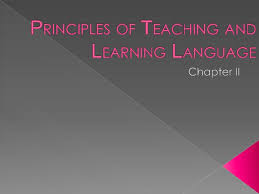Principles of Language learning And Teaching is a matter of practice. The language teacher can teach the language by choosing any of method. But the knowledge’ and application of certain principles help him to teach the same language effectively. While teaching, the teacher must keep in mind the learner, his capability and capacity to learn and above all his environment of learning. Some teachers knowingly use difficult words of English while teaching. They forget the mental ability-and the grasping capacity of the learners. That type of teaching is not good.

Some of the basic principles of Language Learning and Teaching are explained blow:
Imitation: Learning of any language is based on the principle of imitation. We can see from childhood, language is naturally learnt through imitation. It is especially true in the case of small children. Whatever they see all around them, they imitate those things in the same way. Sometimes even the wrong habits of the teacher are carried on by

The small children:
If a teacher has poor pronunciation, his students at the early stages of learning the language will pick up the same poor standard of pronunciation from him. The bad handwriting of the teacher may also have adverse effect on the learners. It has been seen that if some teacher is in the habit of writing with left hand, the students under his charge also acquire that habit of writing with left hand.
So the teacher who is given the charge of teaching the small children must be good through and through, fit’ should have a model type of pronunciation. His handwriting should be very good. He must possess good habits. All this will have very good impact on the growing personalities of the small children. It is, therefore, very strongly recommended that really good teachers should be recruited for teaching the small children in the schools.
Practice and Drill:

Learning of language is a habit formation process. Repetition makes habits of learners. For making Habits formation process Continuous practice and drill work are systematically needed for it. All skills of language learning like writing, speaking, listening can only be got can after continuous practice. So habit formation is the core part of language learning.
Oral Approach:

Language is more connected with listening and speaking. We can see there are many people in this world who can just speak any language but they can’t able to write the language. So in the teaching of English, oral work should be given topmost priority. In modern linguistics, emphasis is given to oral work of a language.
Selection and Gradation:

In the teaching of language, selection and gradation items are very important. Selection may be done by the teacher in respect of grammatical items, vocabulary and structures. Selection and gradation should involve frequency; teach ability applicability, usefulness etc.
Selection; The selection of language’ is based on the following principles:
- Frequency of language items i.e., its occurrence.
- Range of applicability i.e. in how many contexts it is applicable.
- Coverage —a word conveying a number of meanings e.g. meals stand for dinner, breakfast etc.
- Availability -the items which can be conveniently taught e.g. actual objects available in the class-room like table, chair, chalk etc.
- Teach ability items which are easy from teaching point of view.
- Learn ability items which are easy for the students to learn should be taken up first.
Gradation:

Gradation means putting the language items in order of presentation. Thus simple items having more utility and better teach ability will be taken care of. Gradation involves grouping and sequence. 1 ho basic principle of grading according to W. Grouping:
- Group according to the sound e.g. pay, bay, say, etc. This is called phonetic grouping.
- Grouping according to words used in the same situation e.g. words connected with post office-post master, postman, dak, letters. It is called lexical grouping.
- Patterns of sentences which are similar should be taught together e.g., this is, that is my book, your book etc. It is called grammatical grouping.
- Semantic grouping i.e., words that convey similar meanings are grouped together e.g. shelter, hut, house, tent etc.
- Structure grouping-how the selected items fit with each other: sounds into words, words into phrases, phrases into sentences and sentences into contexts.
Sequence-What comes after what?

- Lexical sequence-which words follow which e.g. sit, stand, come, go.
- Grammatical Sequence-means which structure
- follows which
- V.O. For example,
I am throwing a ball.
I am throwing a ball to you.
- Semantic sequence-Every word has a number of meanings. They are put in order and are taught at different occasions e.g., the word ‘there’
The pen is there. (Place)
There are many pens. (Introduction)
Motivation or Interest:
Motivation or interest is of great importance in the teaching-learning process. Language is learnt quickly if interest is created in it. So the language teacher should make use of different types of aids for this purpose. Some interesting methods like activity method play way method can also be used. Thus the learners remain captivated and learn things very actively. They are also able to retain those things in their minds for a longer time.
The Teacher Must know The Principles of Language Learning and Teaching for Optimal Result.

The general poor standard of students in English is due to the lack of interest. Many students learn English half heartedly. They consider it a necessary evil. The teachers themselves are seen criticizing English in their class rooms, I low can there be good teaching-learning of English when both the teacher and the taught lack interest’? The teacher, who cannot make his teaching interesting, should better quit the teaching profession. He should be able to deal with the solutions in such a way that; the learners should become interested both in their teacher and the subject matter.
Natural Way of Teaching:
Natural process of learning the language should be followed. Listening and speaking should precede reading and writing. The teacher should give more emphasis on the first two aspects i.e., listening and speaking. Then the learners will get good command at reading and writing of the language. Some people are of the opinion that listening to some other language, unless mother tongue is fully learnt, is dangerous.
Language should be learnt in Background Context and Situation:
Language is taught so that the learners are able to make use of it in their day-to-day life situations. Different language items, say vocabulary structures etc. should be dealt with in the context or some appropriate situations so that the learner may find them close to life.
Adoption of Multiple Line of Approach: While teaching a foreign language, the multiple line of approach should be followed as it helps the learners and the teacher many ways. Suppose a class is to be taught an essay on Eid. First of all, there should be oral work and after that the students may be asked to write a few sentences on the topic in their note books. Spelling practice is given out of the same topic. While doing translation, sentences on the topic “Eid” be given. Thus our approach to language would be many sided. By correlating the different aspects of the language, we can certainly make the learning of language easy, interesting and useful.
Balanced Approach:
The teacher must focus that the different aspects language are fully taken care of. Listening, speaking, reading and writing should be equally emphasized. Each aspect has its own importance. It is not proper if a teacher teaches grammar and ignores other things. In the same way, emphasis on written work alone does not help much.
There should be proper co-ordination in teaching different aspects of the foreign language. Thus in teaching a prose lesson, grammar aspect may be discussed side by side. While doing written composition, oral aspect should also be covered. Thus a sort, of balance between the different aspects of language should be maintained.
Conclusion
Language learning and teaching are dynamic processes that require a combination of sound principles and strategies. By incorporating the best principles of language learning and teaching, both language learners and teachers can maximize their language acquisition and teaching potential. By staying motivated, actively engaging in language output, considering cultural context, individualizing instruction, providing feedback, and integrating technology, we can create a rich and fulfilling language learning experience for all. So, what are you waiting for? Start applying these principles and embark on your journey towards language proficiency today!
